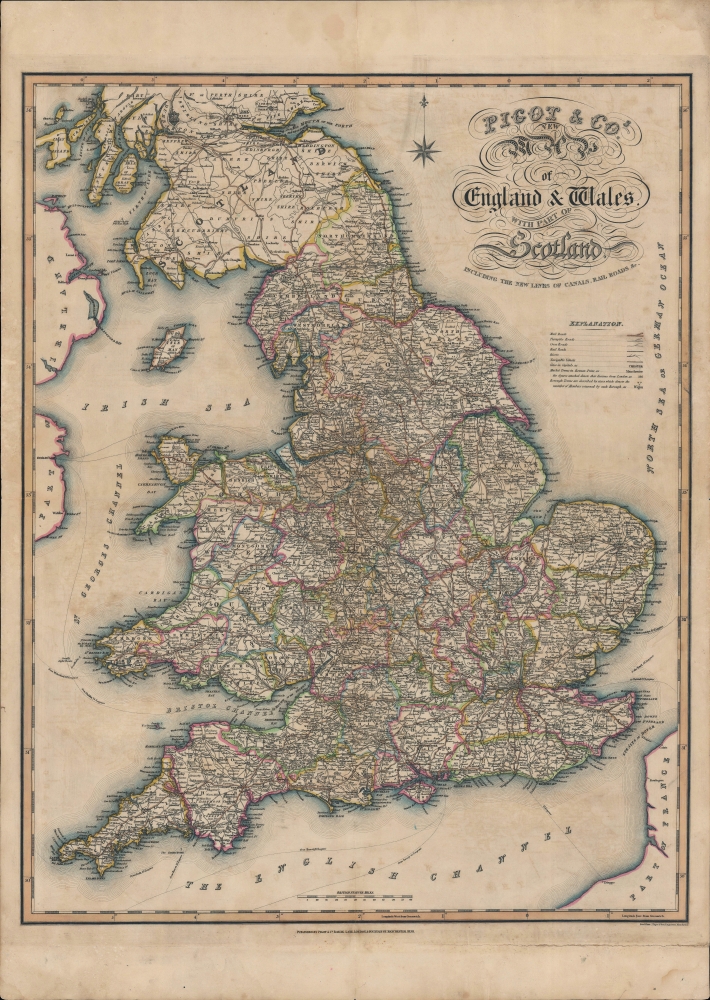1830 Pigot Map of England and Wales
EnglandWales-pigot-1830-2
Title
1830 (dated) 28 x 21 in (71.12 x 53.34 cm) 1 : 1700000
Description
A Closer Look
The map offers extraordinary detail, with hand color outlines of counties and shires. Towns, cities, large estates, canals, railroad lines, and ferries are thoroughly documented. A legend at right explains the notation used throughout, while a highly decorative title crowns the map at top-right.Dawn of the Railway Age
Among the features of this map, perhaps the most notable is the railway line from Liverpool to Manchester, the world's first intercity railway and the first commercially successful railway, opened the same year this map was published. The railway was built with the intention of using stationary steam engines and cables, similar to a cable car, but the railway's chief engineer Robert Stephenson strongly advocated for steam powered locomotives that would pull individual trains. Stephenson's father George was a prominent inventor and had, with him, developed a steam-powered locomotive as well as tracks able to bear the weight of the engines they designed.As the Liverpool and Manchester was nearing completion, the company's directors decided to hold a competition to determine which sort of engine would be most suitable for the railway. Dubbed the Rainhill Trials and taking place in October 1829, the demonstration was a resounding success for Stephenson's Rocket and set the stage for railways to expand at a tremendous pace in Britain, the United States, and elsewhere.
Despite the opposition of some landowners and established canal operators, Parliament and private investors devoted considerable sums to railways in the wake of the Liverpool and Manchester's success. The result was a veritable frenzy of railway building, with companies being formed, gaining Parliamentary approval, and often quickly fizzling out at a near daily rate. The cumulative result was that, by 1850, most of the major, medium, and even small cities of England, and to a lesser extent Wales and southern Scotland, were connected.
Publication History and Census
This map was published in 1830 by (James) Pigot and Co. Pigot's map seems to be based on the work of John Cary, which he reduced and updated for this 1830 publication. It is listed among the holdings of three institutions (the National Library of Scotland, the University of Oxford, and Aberdeen University.Cartographer
James Pigot (fl. 1795 - 1843) was a London based map engraver and map publisher active in the late 19th and early 19th century. Stylistically Pigot's work resembles that of Cary, Thomson, and Pinkerton, though he was far less prolific. The first reference to Pigot is in a 1794 business directory of Manchester, England , where he is listed as an engraver. In 1804 he published a map for Dean's Manchester Directory. Dean must have inspired him for around 1811 he established his own directory, Pigot's Directory, which competed with the Dean Directory until about 1813 when the rivals seem to have merged. Pigot eventually moved to London where he established himself on Basing Lane. There in 1823 he published his first London Directory. Around 1830 his son joined him in the business and it was renamed Pigot & Sons - though the later seems to have little serious interest in the business. In 1939 Pigot partnered with his apprentice, Isaac Slater (1803 - 1883), renaming the firm Pigot & Slater and relocating to more prestigious offices at 59 Fleet Street, London ( though they maintained their offices at 18 Fountain Street, Manchester). Pigot died in 1843 though Slater and his son J. W. Slater continued to operate under the Pigot & Slater name until the firm was acquired by Kelly & Co. in 1892. More by this mapmaker...

